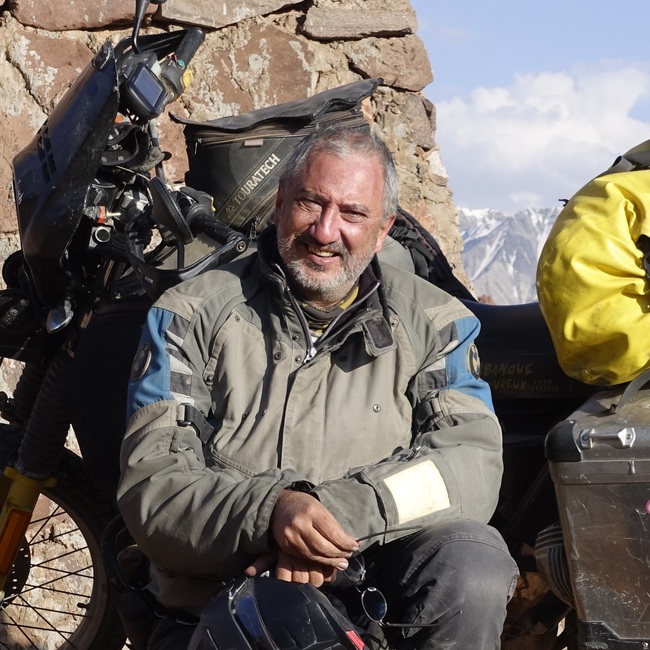
My name is Jean-Jacques, but when I travel I use the nickname Jef, in reference to writer-journalist Joseph Kessel, whose books fueled my imagination when I was a teenager, and since a nomadic life is a real lifestyle for me, I’ve decided to be Jef Le Saltimbanque. My father was an expat and I grew up traveling, in Turkey and in Portugal. During my lifetime, I’ve had several passions in turn – skiing, diving, underground diving, hot air balloons and, especially, horse riding. In 2003-2004, I took my first 16-month motorcycle journey through Africa. I wrote my first book about this adventure (The blue bandana: tales of a promise under the pen-name of Jean-Jacques Aneyota). In 2018, I returned to Asia for 16 months, and now I’m planning a trip around the world without any time limits. My role model is Hubert, who spent the last 14 years of his life traveling. And... Oh yes... I’m about to turn 60.
In this article, I won’t be talking specifically about my motorcycles but about what I think is important to know, check or modify before embarking on a trip around the world – or, at any rate, on a particularly long and demanding journey. Obviously, the type of motorcycle used makes all the difference and I’ll also give you some examples of very specific alterations that I have made to my BMW G650 Xchallenge, which I’ll ride on my next adventures.
In general, I would recommend that you first have a full mechanical overhaul done and replace all high-wear parts, including the clutch plates. You should pay particular attention to the wheels’ bearings, the swingarm and the steering column – make sure they’re all new before you leave. If possible, do all this yourself, in order to learn more about your motorcycle’s mechanics and identify the essential tools you should be taking with you. You don’t need to be a mechanic in order to go on a trip – I was a total beginner when I traveled for the first time! Nonetheless, knowing how to perform at least routine maintenance on your motorcycle is useful.
Servicing all sorted? Actually, that’s not enough. Here’s a list of adjustments or alterations that I recommend doing:
If necessary, have the saddle remade, to make it as comfortable as possible. You’re going to sit on it for several hours a day for months, so comfort is crucial.
Protect the electrical wiring with a water-repellent silicone sleeve (it comes as a spray, and you can spray it on the wiring). This is crucial if you plan to travel in humid, tropical or equatorial regions.
Check the air filtration system and, if necessary, replace it with a more efficient one. In Africa, I checked my air filter every night after a day’s travel. I didn’t do this in Pakistan and I had to replace the piston rings once I arrived in Nepal.
If needed, add some protection on the crankcase. The one I put on the Xchallenge comes with a small toolbox.
If there aren’t any, equip your motorcycle with handguards. In the sub-Sahel region, I saw handguards pierced through by acacia thorns – I can’t imagine what would have happened to the rider’s hands without them.
As part of your preparations, I strongly advise avoiding a top box. Bumps and vibrations on off-road sections almost always break the support plate and, in the worst cases, the motorcycle’s rear frame.
To secure the saddle bag, I’ve been using a ratchet strap for years, which has the advantage of withstanding pretty much anything. Nets or other elasticated means should be avoided.
These are my general tips, but you may still need to make some further alterations depending on the specs of the motorcycle you choose. For example, I increased the engine oil capacity on both my motorcycles to improve their cooling ability. On the Xchallenge, I had the steel rear frame remade so it could take the weight of the luggage – the original aluminum frame was lighter for sure, but it probably wouldn’t have held up. In addition, in some countries it’s basically impossible to have aluminum parts repaired.
Spoked wheels only. Alloy wheels will become irreparably damaged on off-road stretches. As far as tires are concerned, I believe that road enduro tires are the most suitable, as the tread is light and they work well both on asphalt and undemanding off-road stretches. Personally, I’m very satisfied with the Continental TKC 70 tires, which perform quite well in any situation, except for mud. In addition, they last a relatively long time, which is good. I have tubeless tires on my R100, but I always keep a set of inner tubes ready to take with me. Knobby tires should only be used when riding on very long off-road stretches, as in Congo. Their great disadvantage is that they don’t last that long, especially when traveling long distances on asphalt.
Here’s a small list of tools and spare parts you should take with you. Once again, this list really depends on the kind of trip you’re planning and on the availability of spare parts in the areas you are traveling through.
Tools:
You could also take something to repair a hole in the fuel tank (such as liquid metal or resin, depending on the type of tank)
Essential spare parts:
If you think you won’t be able to find them, ship spare parts in advance to some of the cities you will visit; for example:
Shipping spare parts by courier is a rather lengthy and, above all, expensive operation. In addition to shipping costs, which can easily reach 200 euros even for a small package, you need to add customs clearance costs, which in some countries are very high (sometimes more than 100% of the declared value). Therefore, I strongly recommend using this option only if there’s no other choice. Often, it’s actually best to ask a friend to reach you where you are.